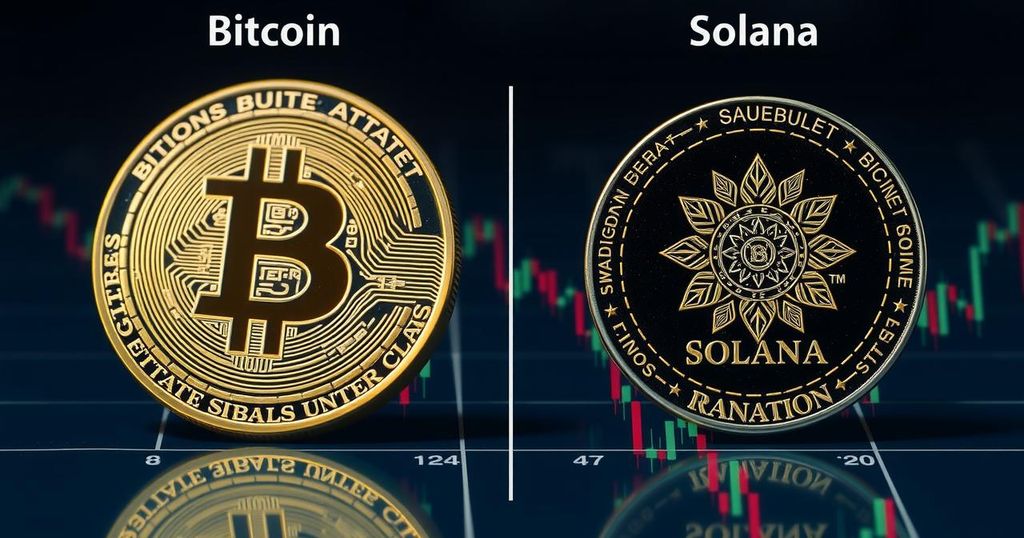Should Investors Consider Switching from Bitcoin to Solana?
This analysis evaluates whether investors should favor Solana over Bitcoin. Bitcoin, despite a price pullback, remains a strong long-term option with significant historical growth. Conversely, Solana offers faster transactions and a robust ecosystem via proof of stake but faces challenges. Both could serve unique investment purposes; a diversification strategy may be advisable for potential gains.
As of December 4, Bitcoin achieved an extraordinary price peak of $103,332, driven by various factors including the approval of its first spot price ETFs, recent mining reward halvings, interest rate reductions, and favorable regulatory policies anticipated from the incoming presidential administration. Despite a modest price decrease since then, Bitcoin has still appreciated over 120% in the last year, maintaining its status as the premier cryptocurrency with a market capitalization of $1.93 trillion.
While Bitcoin remains a strong long-term investment, its growth potential may be overshadowed by alternative cryptocurrencies like Solana. Solana, valued at approximately $190 and possessing a market capitalization of $90 billion, distinguishes itself through its unique validation method known as proof of stake (PoS), which is more energy-efficient than Bitcoin’s proof of work (PoW) mechanism.
Solana’s blockchain provides faster transaction speeds and supports the development of decentralized applications (dApps), non-fungible tokens (NFTs), and various other digital assets. Crucially, PoS tokens like Solana may be staked, offering participants the chance to earn rewards. In contrast, Bitcoin’s value is often associated with its scarcity, as it has a capped supply of 21 million coins with almost 20 million already mined, making it analogous to precious metals such as gold.
In comparison to Ethereum, the second-largest cryptocurrency using PoS, Solana has made strides by implementing a distinct proof-of-history (PoH) technology. This innovation significantly enhances transaction speeds, wherein Solana’s capacity to process transactions can be nearly 46 times faster than Ethereum’s current capability. Despite its rapid transaction processing, Solana has encountered challenges, including network congestion, spam transactions, and security vulnerabilities that have impeded its growth.
As of late 2022, Solana’s price plummeted below $10 following the fallout from the FTX exchange’s collapse, yet it has since rallied, experiencing a substantial recovery. Several major cryptocurrency firms have sought approval for Solana spot price ETFs, which may contribute to its stabilization and attract both retail and institutional investors, potentially elevating Solana’s status in the cryptocurrency realm alongside more established digital assets.
In summary, despite Solana’s promising attributes, investors should not consider it a direct substitute for Bitcoin at this time. Solana presents an enticing investment opportunity for those optimistic about its technological advancements and ecosystem expansion, yet it remains inflationary and thus poses a distinct valuation challenge compared to Bitcoin’s well-defined characteristics. A prudent approach could involve diversifying investments between both Bitcoin and Solana, recognizing their unique strengths and market behaviors.
This article examines the dynamics between Bitcoin and Solana in the cryptocurrency market. Bitcoin, the leading cryptocurrency by market capitalization, has proven itself as a long-term investment with significant historical price performance. Meanwhile, Solana represents a newer player in the field, utilizing innovative technologies like proof of stake and proof of history to enhance transaction efficiency and support a growing ecosystem of decentralized applications. The article assesses their individual characteristics, investment potential, and the implications of recent developments on their market positions.
In conclusion, Bitcoin continues to solidify its position as a stalwart in the cryptocurrency market, embodying scarcity and stability akin to gold. On the other hand, Solana presents a compelling alternative aimed at technological innovation and speed but carries inherent risks and challenges related to its developmental status and inflationary supply. For investors, a dual investment strategy incorporating both Bitcoin and Solana may yield diversified benefits aligning with their risk tolerance and market outlook.
Original Source: www.usatoday.com








Post Comment